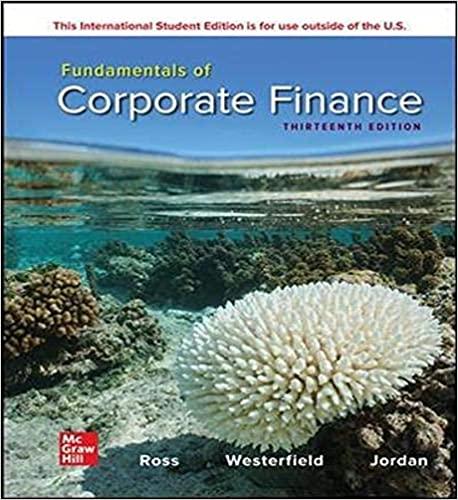Question
Suppose that each of two investments has a 4% chance of loss of $ 10 million, a 2% chance that of loss of $1 million,
Suppose that each of two investments has a 4% chance of loss of $ 10 million, a 2%
chance that of loss of $1 million, and a 94% chance of profit of $1 million. They are
independent of each other.
a)What is the VaR for one of the investments when the confidence level is 95%?
b)What is the expected shortfall when the confidence level is 95%?
c)What is the VaR for a portfolio consisting of the two investments when the
confidence level is 95%?
d)What is the expected shortfall of for a portfolio consisting of the two investments
when the confidence level is 95%?
I have attached the question and solution from a previously unlocked question from course hero: However, I cannot understand how the tutor got any of these answers below, would you please help me understand how they got the answers and why? Thanks!
solution:
A loss of $1 million extends from 94 percentile to 96 percentile point of the loss distribution. Hence, 95% VaR is $1 million.
The expected shortfall is the expected loss conditional which is the loss in the 5 percent tail. We know that we are in tail that there is 20% chance than the loss is $1 million and 80% chance that the loss is $10 million. Hence, the expected shortfall is 0.20*$1 million + 0.80*$10 million = $8.2 million.
For a portfolio of two investments there is 0.04 x 0.04 = 0.0016 chance that the loss is $20 million,
2 x 0.04 x 0.02 = 0.0016 chance that the loss is $11 million,
2 x 0.04 x 0.94 = 0.0752 chance that the loss is $9 million,
0.02 x 0.02 = 0.04 chance that the loss is $2 million,
2 x 0.2 x 0.94 = 0.0376 chance that the loss is zero,
0.94 x 0.94 = 0.8836 chance that the profit is $2 million,
This indicates that the 95% VaR is $9 million.
The expected shortfall is the expected loss conditional which is the loss in the 5 percent tail. We know that we are in tail that there is 0.0016/0.05 = 0.032 chance of the loss is $20 million, a 0.0016/0.05 = 0.032 chance of a loss of $11 million and a 0.936 chance of a loss of $9 million. Hence, the expected shortfall is 0.032*$20 million + 0.032*$11 million + 0.936*$9 million = $9.416 million.
Step by Step Solution
There are 3 Steps involved in it
Step: 1

Get Instant Access to Expert-Tailored Solutions
See step-by-step solutions with expert insights and AI powered tools for academic success
Step: 2

Step: 3

Ace Your Homework with AI
Get the answers you need in no time with our AI-driven, step-by-step assistance
Get Started


